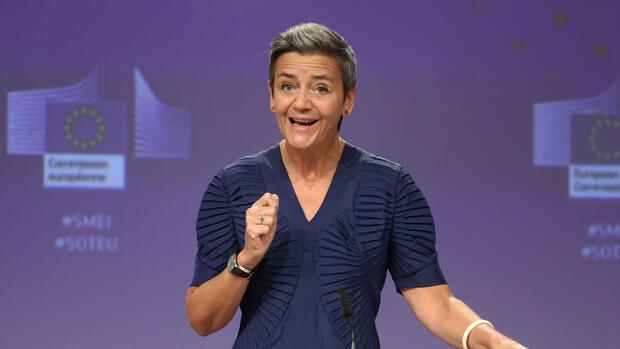The Danish EU Commissioner approved further billions in aid for hydrogen projects on Wednesday.
(Photo: dpa)
Brussels The EU Commission is driving the development of a European hydrogen industry. On Wednesday, she approved a further five billion euros in state aid. This is intended to support 35 hydrogen projects in 13 EU countries. These include the Swedish joint venture Hybrit, which wants to be the first company in Europe to produce “green steel”.
“It is important for Europe to invest in these new technologies. And I don’t think it could happen without public support,” said Margrethe Vestager, the vice-president of the European Commission, in an interview with Handelsblatt and other European newspapers.
The Dane emphasizes that even if the focus at the moment is on relieving households and companies in the energy crisis, one should not forget the long-term perspective. “It is necessary that the energy crisis accelerates the green transition.”
Hydrogen is considered the key to decarbonizing industry. It could replace fossil fuels in the long term. However, companies hesitate to invest as long as there is not enough hydrogen available. That is why the EU is helping with industrial policy.
Top jobs of the day
Find the best jobs now and
be notified by email.
The hydrogen projects are funded as part of a so-called IPCEI (Important Project of Common European Interest). The program relaxes the strict EU subsidy rules. The participating states are then allowed to support selected company projects because it is in the common European interest. According to Vestager, the state aid will trigger seven billion euros in private investments.
EU Commission plans “hydrogen bank”
This time there are no German companies. But at the first hydrogen IPCEI, which Vestager announced in July, four German companies were also funded. These include the “Pegasus” project by Daimler Trucks, the production of electrolysers by the Saxon company Sunfire and fuel cell projects by Bosch and the company Ekpo Fuel Cell Technologies.
“It is necessary that the energy crisis accelerates the green transition.” Margrethe Vestager, Vice President of the European Commission
The Commission also wants to set up a “hydrogen bank” to create demand for hydrogen. “We have a chicken and egg problem at the moment,” says Vestager. “Who needs the hydrogen and who produces it? You need both for the market to work.” The plans are still in an early phase, but the bank should guarantee a minimum price for hydrogen and thus create a certain security for producers.
In total there are now five IPCEI programs in Europe, one for semiconductors, two for batteries and two for hydrogen. Bosch, for example, used the semiconductor program to build state-of-the-art chip factories in Germany. The battery support programs have also triggered a huge wave of private investment, says Vestager. “Europe is now the place in the world that invests the most in battery technology.” In the case of hydrogen, however, it will take a while before the first successes can be seen: some of the projects that have now been approved will run until 2036.
>> Read also: Thyssen-Krupp approves billion-euro investment in green steel – but with reservations
Experts welcome the Commission’s industrial policy interventions. “The EU has an important role to play in the hydrogen sector,” says energy economist Georg Zachmann from the Bruegel Institute in Brussels. You can work towards ensuring that the hydrogen clusters are not only created in the existing industrial centers. However, the sums spent are small compared to what was initially put into renewable energies.
Hydrogen march!
20
million tons
The consulting firm Roland Berger estimates that Europe will consume hydrogen per year in 2030.
Zachmann also advocates creating more scope for experiments. “We act as if we already know what the hydrogen industry of the future will look like,” he says. Due to the regulations, the projects moved within narrow limits. Therefore, “sandboxes” are necessary in which new business models outside of the existing regulatory framework can be tried out.
According to a study by the consulting firm Roland Berger and the mechanical engineering association VDMA, hydrogen consumption in Europe will double from the current ten million tons per year to 20 million tons in 2030.
More: Hydrogen via the normal power grid – EU wants to accelerate hydrogen ramp-up
